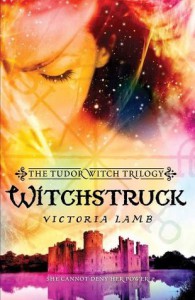Currently reading
The Best American Nonrequired Reading 2013
Minders
Sekret
All the Truth That's in Me
Code Name Verity
Grave Mercy
Witchstruck (The Tudor Witch Trilogy)
 This review and others are posted at Inspiring Insomnia.
This review and others are posted at Inspiring Insomnia.3.5 stars
My knowledge of the Tudor period primarily comes from the Showtime series, The Tudors, the wonderful film, Elizabeth, starring Cate Blanchett, and the occasional historical fiction novel. In other words, my knowledge is not exactly extensive, and I approached Witchstruck with the desire to be entertained and without any thought of wanting to nitpick for accuracy. Obviously, since Lamb decided to feature a witch living alongside the future Queen Elizabeth, we know that this is not intended to be a biography. Lamb's attempt to make this an entertaining work of historical fiction set in the Tudor period was a very nice success. (I apologize in advance if I misinterpret any actual events. I will place all blame on Cate Blanchett.)
Here are the bits that I know to be accurate that Lamb included in the story. Queen Mary and Princess Elizabeth are half-sisters and daughters of the deceased King Henry VIII. Mary's mother was the King's first wife, Catherine of Aragon. Henry divorced Catherine to marry Elizabeth's mother, Anne Boleyn, and I think we all know how that ended. Queen Mary was a devout Catholic and Elizabeth was a Protestant, reflecting the religious divide in the country at the time. Mary believed that Elizabeth would lead a rebellion against her, and she imprisoned Elizabeth for a time to protect her reign.
Where Lamb begins to take liberties with history is with the young witch, Meg Lytton, a maid to Elizabeth. Meg is still attempting to learn the extent of her powers. However, she must keep her powers hidden because being exposed as a witch will lead to her hanging or possibly an even more gruesome death. Elizabeth is aware of Meg's powers and approaches the situation pragmatically. She's happy for Meg to use powers that will benefit her, but she does not want Meg to do anything that will prevent her (Elizabeth) from taking the throne from Mary.
A heavy focus of the story is on a man named Marcus Dent. I'll go ahead and call him a monster, because he does not possess a single redeeming quality. He's a witch-finder, which is explanation enough, but he also happily tortures them to death with no evidence. This charmer also has his eyes set on Meg. This whole plot line was the weakest of the story, and I think the book could have improved without it. I understand the need to show the persecution of suspected witches, but one scene where Dent attempted to rape Meg at the same time he insists he's going to marry her was so distasteful, and it didn't add much to the story.
Much better were the political maneuverings in which Meg aided Elizabeth. This fictional Elizabeth could be bossy and petulant and not exactly regal, but at times, we saw glimpses of the self-assured woman who would become one of England's longest-reigning monarchs. There were interesting parallels between the fictional Lytton family and the actual Boelyn family. In some films and novels, Anne's family is portrayed as a group of schemers, using Anne to gain Henry's favor. While successful for a time, Henry eventually destroyed Anne and her family. In Witchstruck, Meg's family behaves with a similar lack of regard for Meg, seeming to view her only as a tool to advance their family's desires.
I'm looking forward to the additional books in this series, which will hopefully show Meg by Elizabeth's side as she takes the throne.
Note: An ARC was provided by the publisher in exchange for an honest review.








